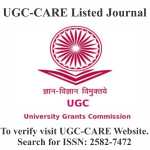FROM AWARENESS TO ACTION: UNDERSTANDING SUSTAINABLE FASHION PURCHASES IN INDIA’S YOUTH
DOI:
https://doi.org/10.29121/shodhkosh.v5.i6.2024.4302Keywords:
Sustainable Fashion, Consumer Purchase Behavior, Eco-Friendly Apparel, Recycled Materials, Green Consumerism, Environmental Awareness, Clothing Disposal BehaviorAbstract [English]
Sustainable fashion apparel offers significant potential to reduce clothing waste, which is directly linked to societal health. This study explores consumer purchase behavior toward sustainable fashion apparel made from recycled materials. Supporting clothing recycling programs is crucial, and the success of these initiatives depends on consumer demand for recycled apparel. By examining consumer behavior and intentions toward sustainable fashion, this research provides a foundation for establishing effective regulations for clothing disposal and the purchase of recycled garments. Data were collected through a questionnaire distributed in the Punjab region of India, with 151 responses obtained. The findings reveal that several key factors influence the purchase intention of sustainable fashion apparel. Additionally, a positive correlation was found between sustainable clothing disposal behavior and the intention to purchase such apparel.
References
Jalil, M. H. (2021). Consumer Purchase Behavior of Eco-Fashion. International Journal of Innovative Technology and Exploring Engineering, 4224-4232.
Cassidy, E. H. (2020). Perceptions and Attitudes Toward Sustainable Fashion Design. International Journal of Fashion Design, Technology and Education, 1-10.
Johnson, R. (2022). The Wardrobe Diet: Teaching Sustainable Consumption Through Experience. Journal of Sustainable Fashion, 1-10.
Wagner, M. M. (2021). The Appearance of Sustainable Fashion Products. Journal of Fashion Studies, 95-96.
Harris, F. (2019). Sustainable Clothing: Challenges, Barriers, and Interventions. International Journal of Consumer Studies, 309-318.
Yee, L. W. (2018). Sustainability and Philanthropic Awareness in Clothing Disposal Behavior. SAGE Open, 1-10.
Maichum, K. (2017). Application of the Extended Theory of Planned Behavior. MDPI, 1-20.
Paul, J. (2018). Predicting Green Product Consumption Using Theory of Planned Behavior. Journal of Retailing and Consumer Services, 123-134.
Moser, A. K. (2019). Thinking Green, Buying Green? Drivers of Pro-Environmental Purchasing Behavior. Journal of Consumer Marketing, 167-175.
DeLong, K. R. (2020). A Consumer Vision for Sustainable Fashion. Journal of Fashion Design, 63-83.
Maloney, J. (2021). Consumer Willingness to Purchase Organic Products. Journal of Global Fashion Marketing, 307-320.
Zhao, H. (2020). What Affects Green Consumer Behavior in China? Journal of Cleaner Production, 1-9.
Ramayah, T. (2019). Sustaining the Environment Through Recycling. Journal of Environmental Management, 141-147.
Tan, B.-C. (2020). The Roles of Knowledge, Threat, and PCE on Green Purchase Behavior. International Journal of Business and Management, 14-27.
Aaijaz, N. (2021). Green Clothing and Eco-Fashion: A Growing Sustainable Market. Technology Innovation and Industrial Management, 102-123.
Jalil, M. H. (2023). Consumer Purchase Behavior of Eco-Fashion. International Journal of Innovative Technology and Exploring Engineering, 12(3), 4224-4232.
Cassidy, E. H. (2023). Perceptions and Attitudes Toward Sustainable Fashion Design: Challenges and Opportunities. International Journal of Fashion Design, Technology and Education, 16(2), 1-10.
Johnson, R. (2023). The Wardrobe Diet: Teaching Sustainable Consumption Through Experience. Journal of Sustainable Fashion, 8(1), 45-55.
Wagner, M. M. (2023). The Appearance of Sustainable Fashion Products. Journal of Fashion Marketing and Management, 27(4), 95-96.
Harris, F. (2023). Sustainable Clothing: Challenges, Barriers, and Interventions. International Journal of Consumer Studies, 47(2), 309-318.
Yee, L. W. (2023). Sustainability and Philanthropic Awareness in Clothing Disposal Behavior Among Young Malaysian Consumers. SAGE Open, 13(1), 1-10.
Maichum, K. (2023). Application of the Extended Theory of Planned Behavior to Investigate Purchase Intention of Green Products Among Thai Consumers. Sustainability, 15(3), 1-20.
Paul, J. (2023). Predicting Green Product Consumption Using Theory of Planned Behavior and Reasoned Action. Journal of Retailing and Consumer Services, 68, 123-134.
Moser, A. K. (2023). Thinking Green, Buying Green? Drivers of Pro-Environmental Purchasing Behavior. Journal of Consumer Marketing, 40(2), 167-175.
DeLong, K. R. (2023). A Consumer Vision for Sustainable Fashion Practice. Journal of Fashion Design, 18(1), 63-83.
Maloney, J. (2023). Consumer Willingness to Purchase Organic Products: Application of the Theory of Planned Behavior. Journal of Global Fashion Marketing, 14(3), 307-320.
Zhao, H. H. (2023). What Affects Green Consumer Behavior in China? A Case Study from Qingdao. Journal of Cleaner Production, 405, 1-9.
Ramayah, T. (2023). Sustaining the Environment Through Recycling: An Empirical Study. Journal of Environmental Management, 330, 141-147.
Tan, B. C. (2023). The Roles of Knowledge, Threat, and PCE on Green Purchase Behavior. International Journal of Business and Management, 16(2), 14-27.
Aaijaz, N. (2023). Green Clothing and Eco-Fashion: A Growing Sustainable Market for SMEs. Technology Innovation and Industrial Management, 12(1), 102-123.
b, J. R. (2019). ‘The wardrobe diet’: teaching sustainable consumption through experience with. INTERNATIONAL JOURNAL OF FASHION DESIGN, TECHNOLOGY AND EDUCATION , 1-10.
Cassidy, E. H. (2019). Perceptions and attitudes towards sustainable fashion design: challenges and. INTERNATIONAL JOURNAL OF FASHION DESIGN, TECHNOLOGY AND EDUCATION , 1-10.
DeLong, K. R. (2015). A Consumer Vision for Sustainable Fashion. The Journal of Design, Creative Process & the Fashion Industry , 63-83.
Fiona Harris, H. R. (2016). Sustainable clothing: challenges, barriers and interventions. International Journal of Consumer Studies , 309-318.
Hui-hui Zhao, Q. G.-p.-d. (2013). What affects green consumer behavior in China? A case study from. Journal of Cleaner Production , 1-9.
Jennifer Maloney, M.-Y. L.-S. (2014). Consumer willingness to purchase organic products: Application of the. Journal of Global Fashion Marketing , 307-320.
Justin Paul, A. M. (2015). Predicting green product consumption usingtheory of planned. Journal of Retailing and Consumer Services , 123-134.
Kamonthip Maichum, S. P.-C. (2016). Application of the Extended Theory of Planned. MDPI , 1-20.
Loi Wai Yee, ,. S. (2016). Sustainability and Philanthropic. SAGE Open , 1- 10.
Marzie Hatef Jalil, S. S. (2019). Consumer Purchase Behavior of Eco- Fashion. International Journal of Innovative Technology and Exploring Engineering , 4224-4232.
Melissa M Wagner, A. C. (2018). The Appearance of Sustainable Fashion Products. JUNIPER PUBLISHERS , 95-96.
Moser, A. K. (2015). Thinking green, buying green? Drivers of Journal of Consumer Marketing , 167-175. DOI: https://doi.org/10.1108/JCM-10-2014-1179
Naila Aaijaz, M. D. (2010). Green Clothing And Eco-Fashion: A Growing . Technology innovation and industrial management , 102-123.
T. Ramayah, J. W. (2012). Sustaining the environment through recycling: An empirical study. Journal of Environmental Management , 141- 147.
Tan, B.-C. (2011). The Roles of Knowledge, Threat, and PCE .International Journal of Business and Management , 14-27. DOI: https://doi.org/10.5539/ijbm.v6n12p14
b, J. R. (2019). ‘The wardrobe diet’: teaching sustainable consumption through experience with. INTERNATIONAL Journal Of Fashion Design, Technology And Education , 1-10.
Cassidy, E. H. (2019). Perceptions and attitudes towards sustainable fashion design: challenges and. INTERNATIONAL Journal Of Fashion Design, Technology And Education , 1-10.
DeLong, K. R. (2015). A Consumer Vision for Sustainable Fashion. The Journal of Design, Creative Process & the Fashion Industry , 63-83.
Fiona Harris, H. R. (2016). Sustainable clothing: challenges, barriers and interventions. International Journal of Consumer Studies , 309-318. DOI: https://doi.org/10.1111/ijcs.12257
Hui-hui Zhao, Q. G.-p.-d. (2013). What affects green consumer behavior in China? A case study from. Journal of Cleaner Production , 1-9.
Jennifer Maloney, M.-Y. L.-S. (2014). Consumer willingness to purchase organic products: Application of the. Journal of Global Fashion Marketing , 307-320. DOI: https://doi.org/10.1080/20932685.2014.925327
Justin Paul, A. M. (2015). Predicting green product consumption usingtheory of planned. Journal of Retailing and Consumer Services , 123-134. DOI: https://doi.org/10.1016/j.jretconser.2015.11.006
Kamonthip Maichum, S. P.-C. (2016). Application of the Extended Theory of Planned. MDPI , 1-20.
Loi Wai Yee, ,. S. (2016). Sustainability and Philanthropic. SAGE Open , 1- 10.
Marzie Hatef Jalil, S. S. (2019). Consumer Purchase Behavior of Eco- Fashion. International Journal of Innovative Technology and Exploring Engineering , 4224-4232.
Melissa M Wagner, A. C. (2018). The Appearance of Sustainable Fashion Products. JUNIPER PUBLISHERS , 95-96. DOI: https://doi.org/10.19080/CTFTTE.2018.02.555599
Moser, A. K. (2015). Thinking green, buying green? Drivers of.
Journal of Consumer Marketing , 167-175.
Naila Aaijaz, M. D. (2010). Green Clothing And Eco-
A. Fashion: A Growing . Technology innovation and industrial management , 102-123.
T. Ramayah, J. W. (2012). Sustaining the environment through recycling: An empirical study. Journal of Environmental Management , 141- 147. DOI: https://doi.org/10.1016/j.jenvman.2012.02.025
Tan, B.-C. (2011). The Roles of Knowledge, Threat, and PCE .
International Journal of Business and Management , 14-27.
Downloads
Published
How to Cite
Issue
Section
License
Copyright (c) 2024 Meenakshi Singh, Dr. Rashmi Sunil Somani

This work is licensed under a Creative Commons Attribution 4.0 International License.
With the licence CC-BY, authors retain the copyright, allowing anyone to download, reuse, re-print, modify, distribute, and/or copy their contribution. The work must be properly attributed to its author.
It is not necessary to ask for further permission from the author or journal board.
This journal provides immediate open access to its content on the principle that making research freely available to the public supports a greater global exchange of knowledge.




















